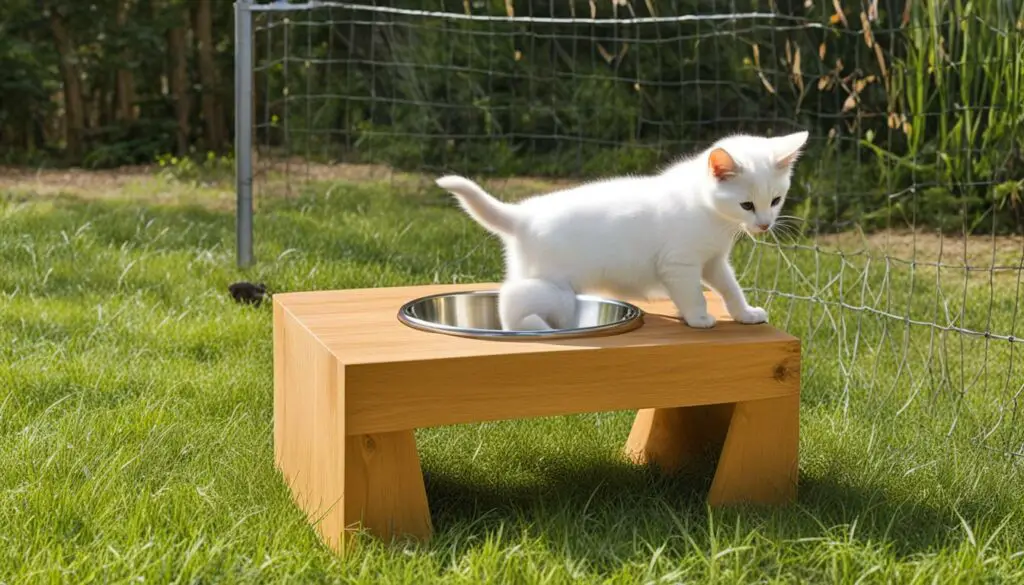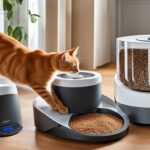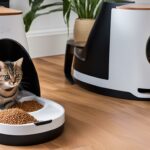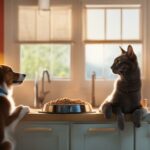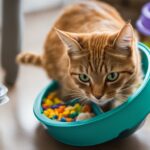Hello, I’m here to shed some light on the important topic of keeping cat food away from dogs. As a pet owner, it’s crucial to understand the implications of dogs consuming cat food and the potential risks it poses to their health. Not to mention, it’s equally vital to ensure that our feline friends receive the nutrition they need without interference.
Dogs eating cat food regularly can experience digestive issues and a lack of proper nutrition, while cats may eat less and risk malnutrition. This is because cat and dog foods are specifically formulated to meet the unique nutritional requirements of each species. Therefore, it’s crucial to find effective solutions to prevent dogs from stealing cat food.
In this article, we’ll explore the reasons why cat food is not suitable for dogs and dive into various strategies and solutions to keep cat food away from dogs. So, let’s delve deeper into this subject and find the best ways to ensure the well-being of both our furry companions.
Key Takeaways:
- Regular consumption of cat food by dogs can lead to digestive issues and nutritional deficiencies.
- Cat food is specifically formulated to meet the unique nutritional needs of cats, which differ from those of dogs.
- Effective solutions to prevent dogs from eating cat food include using selective pet feeders, elevating the food, setting up separate feeding stations, and implementing training techniques.
- Feeding pets according to a schedule and pet-proofing the feeding area can also help keep cat food away from dogs.
- Using scent and taste deterrents can discourage dogs from eating cat food.
Why Cat Foods Are Not Good For Dogs
When it comes to pets, nutrition plays a vital role in their overall health and well-being. As cat and dog owners, it’s essential to understand that cat foods are specifically formulated to meet the unique nutritional requirements of cats, which differ from those of dogs.
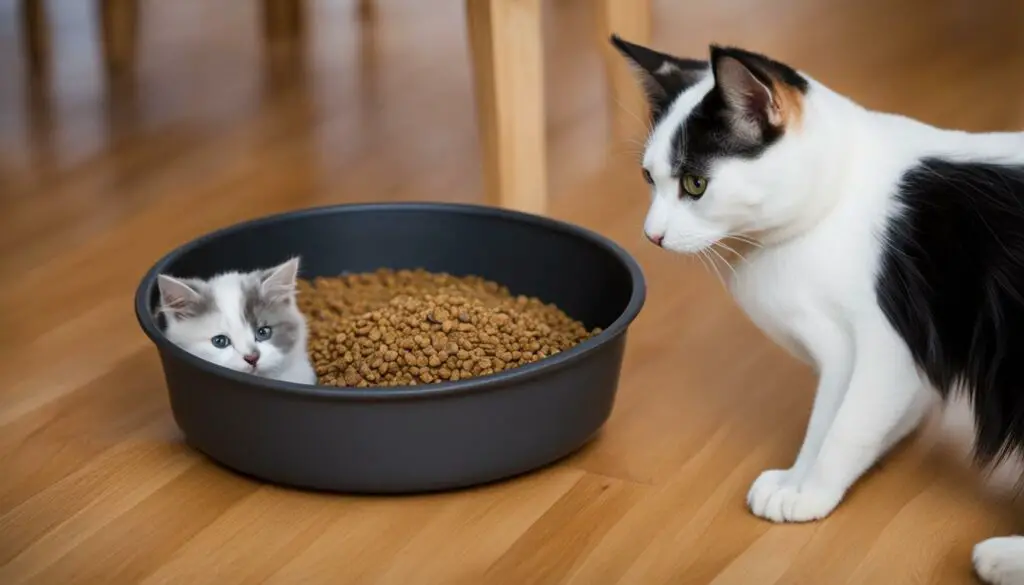
Cats are obligate carnivores, meaning their bodies require a higher amount of protein and fats compared to dogs. They also have specific dietary needs, such as the amino acid Taurine, which is essential for their heart health. On the other hand, dogs are omnivores and need a balanced diet that includes more carbohydrates.
Feeding dogs cat food regularly can have detrimental effects on their health. The lack of proper nutrition, including essential nutrients like Taurine, can lead to long-term health issues. Additionally, the higher protein and fat content in cat food can cause digestive problems in dogs, such as gastrointestinal upset, pancreatitis, and obesity.
Key Differences Between Cat and Dog Food
| Cat Food | Dog Food | |
|---|---|---|
| Protein | Higher content | Lower content |
| Fat | Higher content | Lower content |
| Taurine | Essential | Not necessary |
| Carbohydrates | Lower content | Higher content |
As shown in the table above, Cat Food and dog food have distinct nutritional compositions to meet the specific dietary needs of each species. It’s crucial to feed cats and dogs with the appropriate food to ensure they receive the optimal nutrition for their health and well-being.
Solutions to Stop Your Dog from Eating the Cat’s Food
When it comes to keeping your dog away from the cat’s food, there are several effective solutions available. These solutions can help ensure the health and well-being of both your pets. Let’s take a closer look at some of the most popular options:
- Replace the food bowl with an automatic selective pet feeder: Automatic selective pet feeders, such as the SureFeed, Wireless Whiskers, and PortionPRO RX, are designed to open only when the cat’s collar tag or microchip is detected. This ensures that only the cat has access to the food, keeping it out of reach for the dog.
- Elevate the food to make it unreachable to the dog: Placing the cat’s food in an elevated location can be an effective solution. You can use a wall-mounted cat dining table or a feeder shelf that allows the cat to jump up and eat while keeping the food out of the dog’s reach. This not only prevents the dog from accessing the food but also creates a dedicated space for the cat’s mealtime.
- Set up a cat feeding station where dogs don’t fit: Cat feeding stations, such as the Feed-Safe or a cat enclosure, can provide a separate area for the cat’s food that is inaccessible to dogs. The Feed-Safe is a dome-shaped feeding station with small doors that allow the cat to access the food while keeping the dog out. Cat enclosures, like the Petsfit Pet House, offer a dedicated space for the cat’s meals.

These solutions can help you ensure that your dog doesn’t eat the cat’s food, promoting the health and well-being of both pets. Choose the method that works best for your specific situation and ensure that both your dog and cat receive the proper nutrition they need.
Replace The Food Bowl With An Automatic Selective Pet Feeder
If you’re looking for a convenient and effective solution to keep your dog away from your cat’s food, consider replacing the traditional food bowl with an automatic selective pet feeder. These innovative feeders are specially designed to ensure that only your cat can access their food, while keeping it completely inaccessible to your dog.
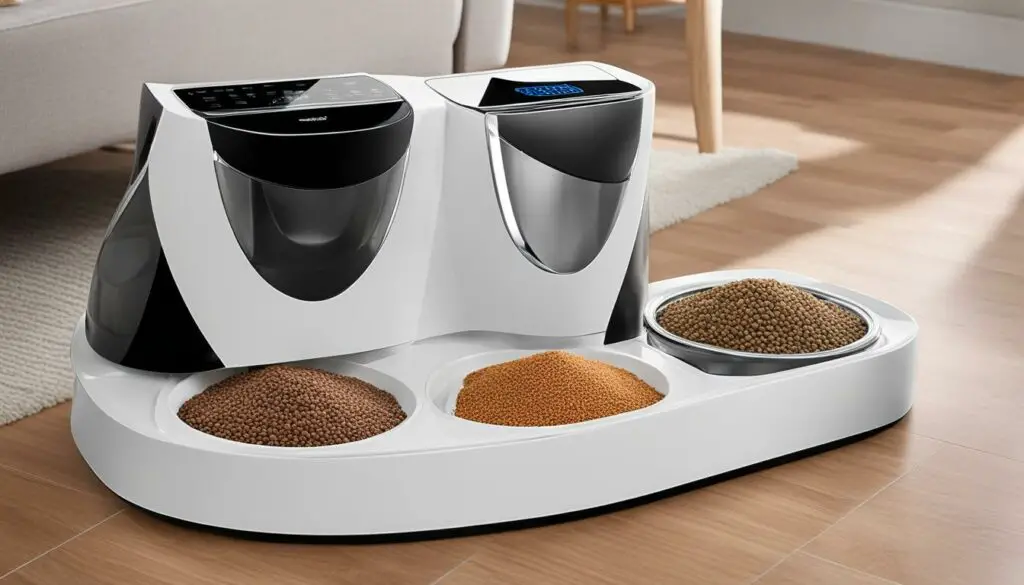
There are several brands of automatic selective pet feeders available, such as the SureFeed, Wireless Whiskers, and PortionPRO RX. These feeders work with a sensor or a collar tag/microchip worn by your cat, allowing the feeder to open only for them. This means that whenever your cat approaches the feeder, it will automatically open, allowing them to enjoy their meal undisturbed. The dog, on the other hand, won’t be able to access the feeder, preventing them from stealing your cat’s food.
By using an automatic selective pet feeder, you can ensure that your cat receives the proper nutrition they need without the risk of your dog eating their food. It’s a simple yet effective solution that can help maintain the health and well-being of both your pets.
Benefits of Using an Automatic Selective Pet Feeder:
- Prevents food theft: The selective design ensures that only your cat can access the food, keeping it safe from your dog.
- Healthier eating habits: By controlling your cat’s portions and preventing your dog from overeating, an automatic feeder promotes healthier eating habits for both pets.
- Convenience: Automatic feeders can be programmed to dispense food at specific times throughout the day, making it easier to manage your pets’ feeding schedule.
- Peace of mind: With an automatic selective pet feeder, you can have peace of mind knowing that your cat’s food is secure and your pets are receiving the nutrition they need.
Investing in an automatic selective pet feeder is a smart choice for pet owners who want to ensure that their dog doesn’t eat their cat’s food. Not only does it prevent food theft, but it also promotes healthier eating habits and provides convenience for both you and your pets. Consider incorporating an automatic selective pet feeder into your pet care routine to keep your pets happy, healthy, and well-fed.
Elevate The Food To Make It Unreachable To The Dog
One effective solution to prevent dogs from accessing the cat’s food is to elevate the food bowl or use a wall-mounted cat dining table. By placing the food in a location that is physically higher and inaccessible to the dog, it creates a barrier that prevents the dog from reaching the food.
There are several options available for elevating the food. One option is to use a raised feeding station that is specifically designed to keep the food out of the dog’s reach. These stations typically have elevated platforms or stands that elevate the food bowl off the ground. This not only makes it physically harder for the dog to reach the food, but it also creates a visual barrier that signals to the dog that the food is off-limits.
Another option is to use a wall-mounted cat dining table. These tables are designed to be securely mounted on the wall, out of the dog’s reach. They provide a designated space for the cat to jump up and eat without the dog being able to access the food. Companies like CatastrophiCreations offer wall-mounted feeder shelves that not only serve the practical purpose of keeping the dog away from the food but also add a stylish element to your home decor.
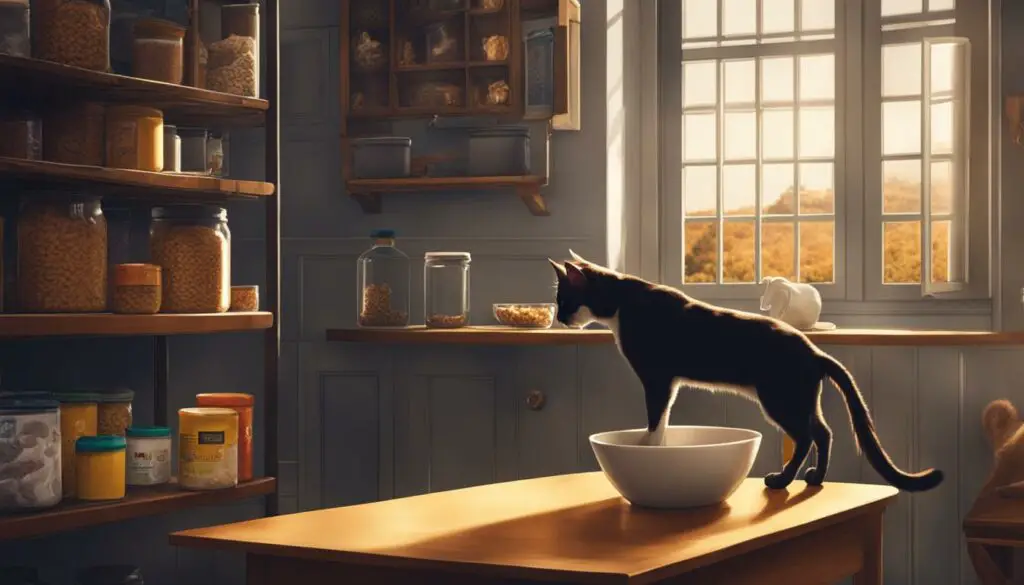
Comparison of Different Methods to Elevate the Food:
| Method | Pros | Cons |
|---|---|---|
| Raised feeding station | – Effectively elevates the food – Creates a visual barrier – Can be aesthetically pleasing |
– May take up more space – Some dogs may still be able to reach the food |
| Wall-mounted cat dining table | – Keeps the food completely out of the dog’s reach – Adds a stylish element to your home decor |
– Requires installation on the wall – Limited to specific areas of the house |
Choosing the right method to elevate the food depends on your specific needs and preferences. Consider factors such as the size of your dog, the layout of your home, and the overall aesthetic you want to achieve. It’s important to find a solution that effectively prevents the dog from accessing the cat’s food while still allowing the cat to comfortably eat.
Set Up a Cat Feeding Station Where Dogs Don’t Fit
If you have a dog that constantly tries to steal your cat’s food, setting up a cat feeding station in an area where dogs can’t access is an effective solution. By creating a dedicated space for your cat’s food, you can ensure that your dog doesn’t have the opportunity to indulge in it.
One option is to use a cat enclosure or a separate room for the cat’s feeding area. Cat enclosures, such as the Petsfit Pet House, provide a safe and enclosed space where your cat can enjoy their meals undisturbed. These enclosures typically have small openings or doors that are too small for dogs to fit through.
Another option is to use a specially designed cat feeding station like the Feed-Safe. This dome-shaped feeding station has two small doors that allow the cat to access the food while keeping the dog out. It provides a secure and controlled environment for your cat’s meals.
By setting up a cat feeding station where dogs don’t fit, you can ensure that your cat gets the nutrition they need without having to worry about your dog stealing their food.
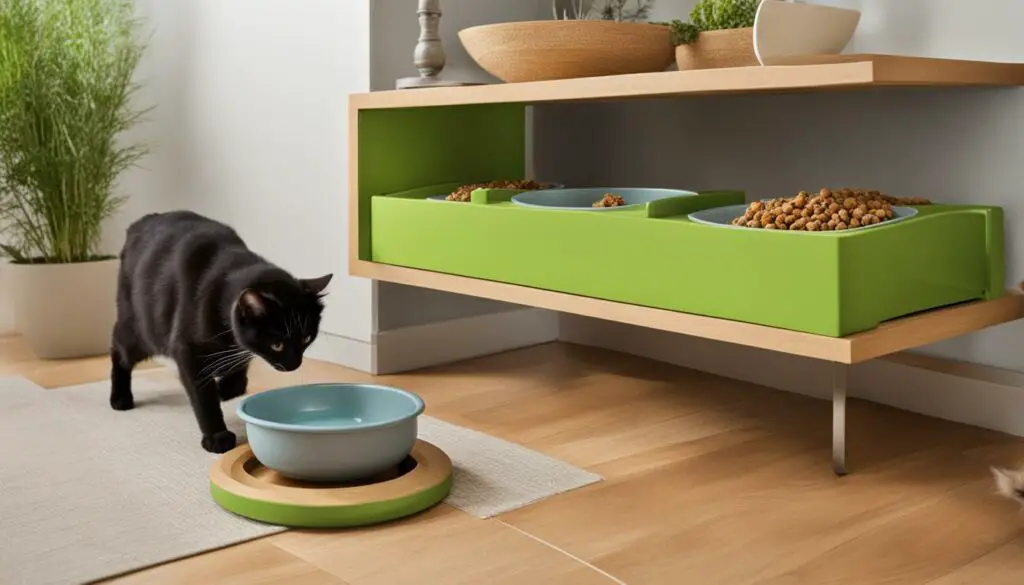
Table: Comparison of Cat Feeding Stations
| Product | Description |
|---|---|
| Feed-Safe | A dome-shaped feeding station with two small doors that allow the cat to access the food while keeping the dog out. |
| Petsfit Pet House | A cat enclosure that provides a safe and enclosed space for your cat’s feeding area. |
Feed Your Pets In Separate Rooms By Setting Up A Pet Gate Or A Cat Door
Feeding your pets in separate rooms can be an effective solution to prevent your dog from eating the cat’s food. By creating a designated feeding area for each pet, you can ensure that they have their own space and reduce the chances of food stealing. One practical way to achieve this is by setting up a pet gate or installing a cat door.
A pet gate can be installed in a doorway or hallway, allowing you to restrict access to specific areas of your home. Look for a pet gate that includes a small cat door, which will allow your feline friend to freely move between rooms while keeping the dog out. This way, you can conveniently feed your pets in separate spaces without worry.
If you prefer a more permanent solution, consider installing a cat door in a door or window. A cat door provides your cat with easy access to their feeding area while keeping the dog out. Make sure to choose a cat door that is the appropriate size for your cat and install it at a height that is comfortable for them to use.
| Pet Gate | Cat Door |
|---|---|
| Restricts the dog’s access to the feeding area | Allows the cat to freely move between rooms |
| Convenient for keeping pets separated | Provides easy access for the cat to their feeding area |
| Can be easily installed in a doorway or hallway | Can be installed in a door or window |
Remember to consider the size and layout of your home when choosing between a pet gate or a cat door. The goal is to create a safe and comfortable environment for both your cat and dog during meal times.
Maintaining separate feeding areas for your pets can help ensure that they receive the appropriate nutrition without one stealing from the other. Whether you opt for a pet gate or a cat door, these solutions provide a practical way to feed your pets in separate rooms, reducing the chances of food theft and promoting harmony in your home.
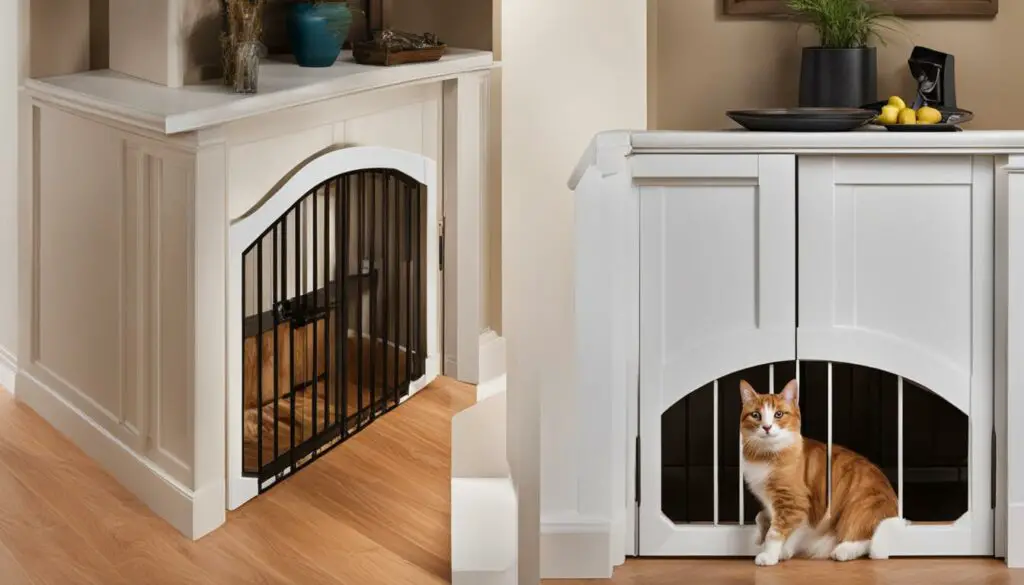
Use Training Techniques to Deter Dogs from Eating Cat Food
When it comes to keeping your dog away from the cat’s food, training techniques can be highly effective. By using positive and negative reinforcement, you can teach your dog to stay away from the cat’s food bowl. Consistency and clear communication are key to successfully training your dog to avoid eating cat food.
To deter your dog from eating cat food, start by creating a designated feeding area for the cat. Place the cat’s food bowl in a separate location where the dog cannot access it. This will help establish a clear boundary between the cat’s food and the dog’s food.
Next, use positive reinforcement to reward your dog for leaving the cat’s food alone. Whenever your dog shows no interest in the cat’s food or walks away from it, praise and reward them with a treat or verbal praise. This will reinforce the behavior of staying away from the cat’s food.
On the other hand, if your dog attempts to eat the cat’s food, use negative reinforcement to discourage this behavior. Use a firm “no” or a corrective sound, such as a clap or a whistle, to interrupt your dog and redirect their attention away from the cat’s food. It’s important not to punish or scold your dog, as this can create fear or aggression. Instead, focus on redirecting their behavior and offering alternative activities or treats.
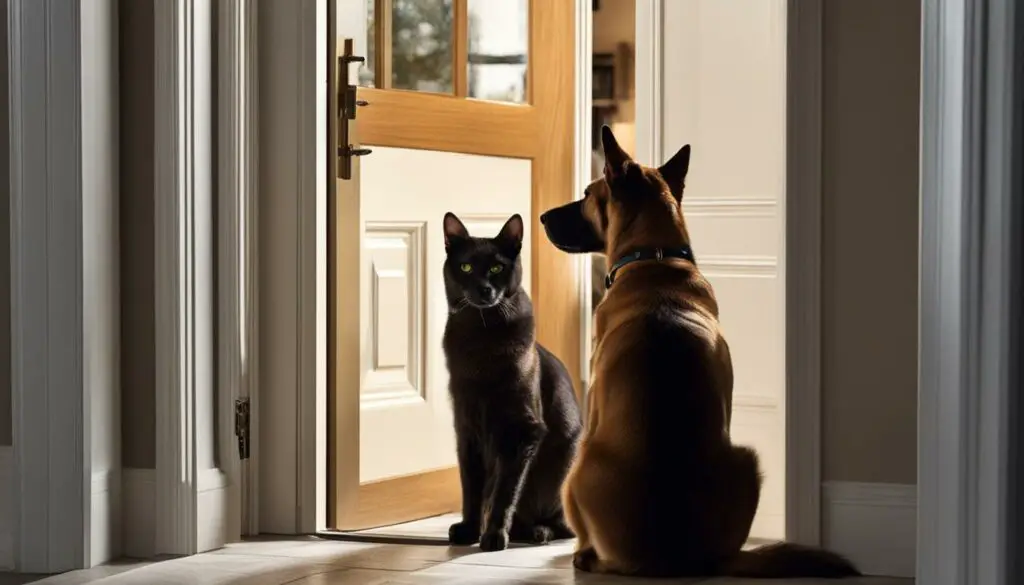
“Consistency and clear communication are key to successfully training your dog to stay away from the cat’s food.”
Summary:
Training techniques can be used to deter dogs from eating cat food. By using positive reinforcement for leaving the cat’s food alone and negative reinforcement for attempting to eat it, you can teach your dog to stay away from the cat’s food bowl. Consistency and clear communication are essential for successful training. Remember to create a separate feeding area for the cat, reward your dog for good behavior, and redirect their attention when they show interest in the cat’s food. With patience and consistency, you can train your dog to respect the boundaries and keep the cat’s food safe.
Feed Your Pets According To A Schedule
Establishing a consistent feeding schedule for both your cat and dog is an effective way to prevent the dog from eating the cat’s food. By feeding them at different times, you can ensure that the cat’s food is not accessible to the dog. This also allows you to monitor each pet’s food intake and make any necessary adjustments to their diets.
Creating a feeding schedule helps regulate your pets’ eating habits and prevents free feeding, where the food is available all the time. Free feeding can lead to the dog stealing the cat’s food and can disrupt their meal routines. By following a schedule, you can control portions and ensure that each pet is receiving the proper amount of food.
When establishing a feeding schedule, consider your pets’ individual needs and dietary requirements. Cats typically require smaller, more frequent meals, while dogs are often fed larger meals once or twice a day. Consult with your veterinarian to determine the ideal feeding times and portion sizes for your pets.
It’s important to stick to the feeding schedule consistently. Set a specific time for each meal and avoid leaving food out for extended periods. If the cat does not finish its meal within a certain timeframe, remove the food to prevent the dog from accessing it. By adhering to a schedule, you can ensure that both your cat and dog are receiving the nutrition they need while keeping the cat’s food safe from the dog’s reach.
| Pets | Feeding Times |
|---|---|
| Cat | Morning: 8:00 AM Evening: 6:00 PM |
| Dog | Morning: 7:00 AM Evening: 5:00 PM |
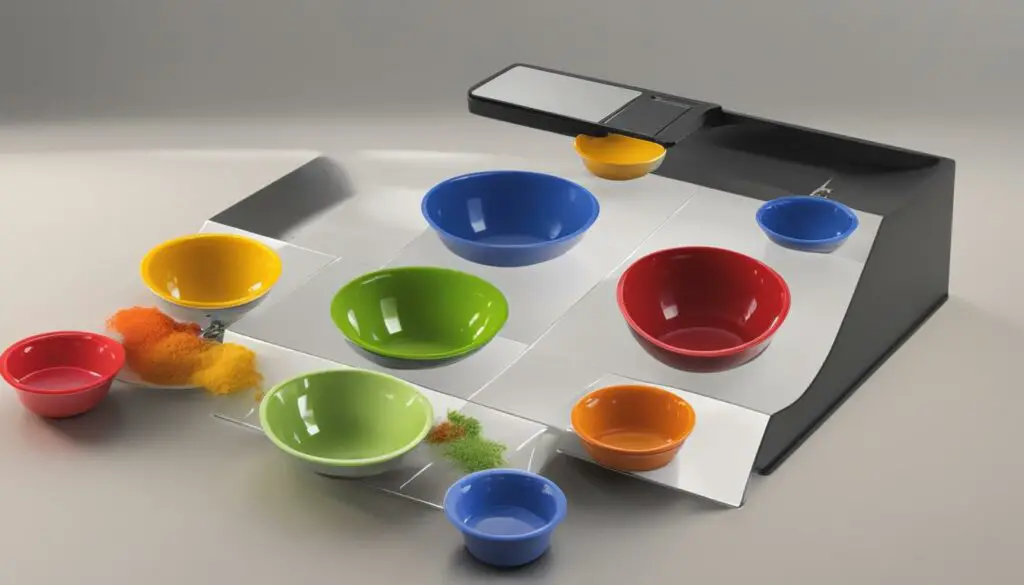
Pet-Proofing To Prevent Access To Cat Food
When it comes to keeping your dog away from your cat’s food, pet-proofing the feeding area is essential. By creating a designated space that is inaccessible to your dog, you can ensure that your cat can eat without any interruptions. There are a few effective pet-proofing strategies that you can implement to prevent your dog from accessing the cat food.
Using Pet Gates or Barriers
One option is to use pet gates or barriers to create a secure area for your cat’s food. These gates can be installed in doorways or entrance areas, restricting your dog’s access to the feeding area. Choose a gate that is tall enough to prevent your dog from jumping over and secure enough to withstand any attempts to push through.
Securely Storing Cat Food
Another important aspect of pet-proofing is securely storing the cat food. Make sure to keep the cat food in a cabinet or container that your dog cannot open. Opt for storage solutions with tight lids or locks to ensure that your dog cannot get to the food. This will help prevent any accidental snacking by your dog.
Creating a Separate Feeding Area
If you have enough space in your home, consider creating a separate feeding area specifically for your cat. This could be a separate room or a defined space within a room that your dog cannot access. By setting up a dedicated feeding station for your cat, you can ensure that your dog won’t be able to reach the food.
| Pet-Proofing Strategy | Benefits |
|---|---|
| Using Pet Gates or Barriers | Restricts dog’s access to the feeding area |
| Securely Storing Cat Food | Prevents accidental snacking by the dog |
| Creating a Separate Feeding Area | Ensures the cat’s food is in a dog-free zone |
By implementing these pet-proofing strategies, you can create a safe and secure environment for your cat’s food. Remember, it’s important to ensure that both your cat and dog are receiving proper nutrition and care, so make sure to monitor their feeding habits and adjust accordingly.
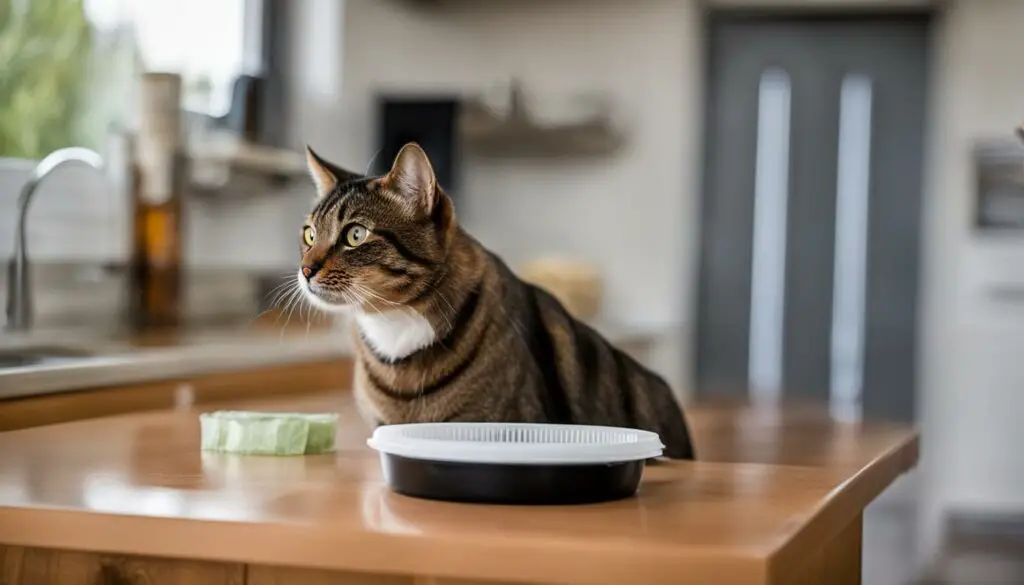
Use Scent and Taste Deterrents
When it comes to keeping your dog away from the cat’s food, scent and taste deterrents can be incredibly effective. By making the cat’s food unappetizing to dogs, you can discourage them from even attempting to eat it. There are various pet-safe deterrents available that can help you achieve this.
A scent deterrent can be applied to the cat’s food, creating an odor that dogs find unappealing. This can be particularly helpful if your dog relies heavily on their sense of smell when deciding what to eat. Additionally, taste deterrents can be added to the cat’s food, making it unpleasant for dogs to consume. These deterrents are often formulated to be safe for pets while effectively deterring dogs from eating the cat’s food.
It’s important to follow the instructions provided with the deterrents to ensure their effectiveness and safety. By using scent and taste deterrents, you can create a barrier between your dog and the cat’s food, helping to protect the health and nutrition of both pets.
“Scent and taste deterrents can be highly effective tools in keeping dogs away from the cat’s food. By utilizing these pet-safe options, you can make the cat’s food unappealing to dogs, ensuring they are less likely to attempt to eat it.”
– Pet Nutrition Expert
| Taste Deterrents | Scent Deterrents |
|---|---|
| Ingredients that create an unpleasant taste for dogs | Odor that dogs find unappealing |
| Safe for pets to consume | Formulated to be pet-safe |
| Can be added directly to the cat’s food | Applied to the cat’s food to create an odor |
Using scent and taste deterrents can help in effectively keeping your dog away from the cat’s food. By making the food less enticing to dogs, you can protect your cat’s nutrition and prevent potential health issues. Remember to use pet-safe deterrents and follow the instructions provided for optimal results. With the right deterrents, you can ensure that your pets enjoy their meals separately and in a healthy manner.

Conclusion (Summary of Key Points)
In conclusion, it is vital to keep cat food away from dogs for the health and well-being of both pets. Cat and dog foods are nutritionally different, meeting the unique dietary requirements of each species. Regular consumption of cat food by dogs can lead to digestive issues and nutritional deficiencies, while cats may suffer from malnutrition if they eat less due to the presence of dogs around their food.
Fortunately, there are several effective solutions to prevent dogs from eating cat food. One option is to replace the traditional food bowl with an automatic selective pet feeder that only opens when the cat’s collar tag or microchip is detected. Elevating the cat’s food to make it unreachable for the dog can also be effective. By setting up a separate feeding station or using pet gates and cat doors, dogs can be prevented from accessing the cat’s food. Training techniques and establishing a consistent feeding schedule for both pets further contribute to successful cat food protection.
To ensure the utmost safety, pet-proofing the feeding area and using scent and taste deterrents can also be beneficial. By incorporating these strategies, pet owners can create a harmonious environment where both cats and dogs receive the proper nutrition they need without any risks or conflicts.
FAQ
Why is it important to keep the dog away from the cat’s food?
Keeping the dog away from the cat’s food is important for the health of both pets. Dogs eating cat food regularly can experience digestive issues and a lack of proper nutrition, while cats may eat less and risk malnutrition.
How are cat and dog foods nutritionally different?
Cat foods are specifically formulated to meet the nutritional needs of cats, which differ from those of dogs. Cats require more protein and fats, while dogs need more carbohydrates and do not need certain amino acids like Taurine.
What are some effective solutions to prevent dogs from eating cat food?
There are several effective solutions to prevent dogs from eating cat food. Some options include using automatic selective pet feeders, elevating the food to make it unreachable for the dog, setting up a separate cat feeding station, feeding pets in separate rooms, implementing training techniques, and pet-proofing the feeding area.
How can an automatic selective pet feeder help keep the dog away from the cat’s food?
Automatic selective pet feeders, such as the SureFeed, Wireless Whiskers, and PortionPRO RX, work with a sensor or a collar tag/microchip worn by the cat. They only open when the cat’s tag or microchip is detected, ensuring that the dog cannot eat from the feeder.
How can I elevate the cat’s food to make it unreachable for the dog?
You can elevate the cat’s food by using a wall-mounted cat dining table or a feeding station that places the food out of the dog’s reach. CatastrophiCreations offers a wall-mounted feeder shelf that allows the cat to jump up and eat without the dog being able to access the food.
How can I set up a cat feeding station where dogs don’t fit?
You can set up a cat feeding station in an area where dogs can’t access, such as an enclosed feeding station or a separate room. Cat feeding stations like the Feed-Safe or cat enclosures like the Petsfit Pet House can be used to create a dedicated space for the cat’s food that the dog cannot reach.
How can I feed my pets in separate rooms to prevent the dog from eating the cat’s food?
You can feed your pets in separate rooms by installing a pet gate or a cat door to restrict the dog’s access to the feeding area. Pet gates with small cat doors or installing a cat door in a door or window can keep the dog out while allowing the cat to freely access the feeding area.
Are there training techniques to deter dogs from eating cat food?
Yes, training techniques can be used to deter dogs from eating cat food. This can include positive reinforcement for leaving the cat’s food alone and negative reinforcement for attempting to eat it. Consistency and clear communication with the dog are key to successfully training them to stay away from the cat’s food.
How can sticking to a feeding schedule help prevent the dog from eating the cat’s food?
By feeding your pets at different times and sticking to a schedule, you can ensure that the cat’s food is not accessible to the dog. It’s important not to leave food out for free feeding, as this can lead to the dog stealing the cat’s food.
How can I pet-proof the feeding area to prevent the dog from accessing the cat’s food?
Pet-proofing the feeding area can be done by using pet gates or barriers to create a designated space for the cat’s food that is inaccessible to the dog. Securely storing the cat’s food in a cabinet or container that the dog cannot open is also important.
Are there scent and taste deterrents that can discourage dogs from eating cat food?
Yes, spraying the cat’s food with a scent deterrent or adding a taste deterrent to the food can make it unappetizing for the dog. It’s important to use pet-safe deterrents and follow the instructions carefully to ensure effectiveness.

